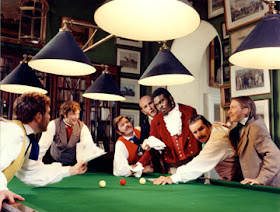| |||
Heads of Six of Hogarth's Servants |
c.1750-1755 London,Tate Gallery |
Dr Gus Casely-Hayford shows how our sense of identity was changed forever by the most distinctively British artist this country has ever produced: William Hogarth.
Until the 18th century, the only vision of Britishness that was available in our art was for and about the toffs. But in the 18th century a revolution occurred: a revolution in ink and paint rather than blood. For the very first time, it was possible to look at our art and see people who are identifiably 'us'. It's all thanks to Hogarth.
No other artist looked at Britain in the way that Hogarth did. There's no one in the art of Europe like him. Hogarth was born poor in London, to whose teeming streets he turned for inspiration throughout his life. Hogarth's London, by far the biggest city in Europe, was not only a great subject for the artist; it was the crucible in which British identity was forged.
Gus has a personal fascination with this story because in 1748, his ancestor, William Ansa, arrived in London from Africa. William had left the Gold Coast, where his father was a wealthy trader, for England to seek his fortune. But the ship's captain had tricked him into slavery and he had spent four years working on a sugar plantation in Barbados.
His case became a cause celebre. The good people of London petitioned for William's freedom and by the time he eventually got here, he was already famous. Gus has always wondered what William might have seen and felt in London. He finds the answers in the life and work of Hogarth.
Uniquely among artists at the time, there are black people everywhere in Hogarth. For Gus, it's an acknowledgement that the lives of people like William Ansa are part of British history too.
Hogarth's inclusive vision of British identity seemed horrifyingly vulgar to the ruling classes of his day. On the whole, the artistic elite shunned the rowdy life of the streets. They wanted a more elegant, chaste vision of British identity. Hogarth wanted art that depicted Britain in all its ugly, rude reality.http://www.channel4.com/programmes/the-genius-of-british-art/4od#3128576
Art of Yinka Shonibare | Diary of a Victorian Dandy - 1998 Collection







No comments:
Post a Comment
Note: only a member of this blog may post a comment.